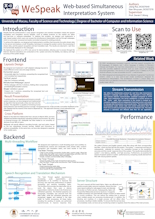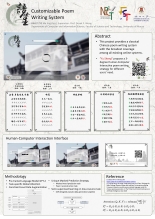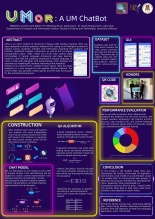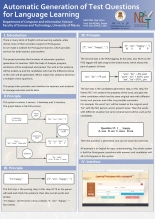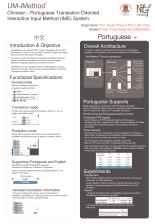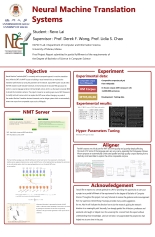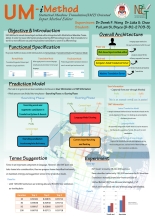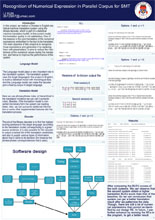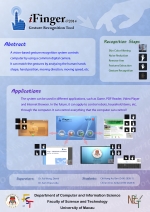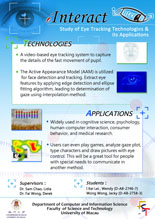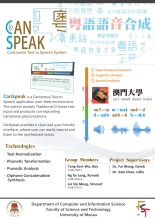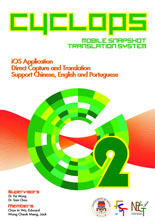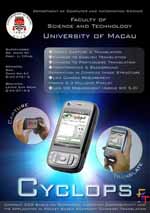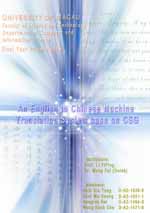FYP Projects
Academic Year 2023/2024
(1) WeSpeak: Web Based Simultaneous Interpretation System
Despite that the achievements in auto speech recognition and machine translation makes the speech recognition and translation service feasible, most of related products on the market are either non-real-time or software-embedded.To address this problem, we designs and implements a web-based system which users can access the simultaneous interpretation service through webpages, which is more easily-accessed and easily-promoted compared to existing products.
To achieve this objective, we designed and implemented a workflow that transmits the audio stream data to the server and employs a multi-threading technique to manage the system control, the processing of stream data, and the speech recognition and text translation task. The results are returned in real-time and dynamically displayed on the webpages.
We deployed the system on a CPU-only server, allowing user to access through the Internet. Several evaluations are conducted on the system and show the liability, low latency and high accuracy of the system design.
Members:
Jiang Rui
Nan Shuyuan
Prizes awarded:
- The Dean’s Final Year Project List, FST-UM (2023)

(2) Vislegal: Legal Data Visualisation
This project aims to develop an efficient and accurate legal sourcing system for the legal system of Macau, addressing the challenges of legal information retrieval. The project will construct a structured legal dataset, develop a user-friendly legal sourcing webpage, embed AI technology for enhanced search efficiency, and support legal research and practice for legal professionals, scholars, and the public.
Members:
Hoi Meng Ieong

(3) iTaolu – An Interactive Chinese Martial Arts Forms Generation System
iTaolu is a web-based application that we have created to perform routine generation. By utilizing the remarkable learning and generation ability of GPT 4.0, iTaolu is able to generate new Nanquan routines from previous routines performed in international competitions. Although the collected routines from previous competitions are scarce, the In-Context Learning (ICL) ability exhibited in Large Language Models (LLMs) allows GPT 4.0 to generate Nanquan routines with limited data.
Members:
Wong Sam In
Academic Year 2022/2023
(1) iSpeak: A Cantonese Text-to-Speech System
The proposed Cantonese Text to Speech project aims to address the lack of research and resources available for this underrepresented language. This project seeks to develop a high-quality TTS system for Cantonese that is both linguistically and culturally appropriate.
One of the biggest challenges in this project is the lack of open-source data sets for Cantonese. In addition, Cantonese is a tonal and complex language, with a large number of characters and nuances that make it difficult to accurately capture in a speech synthesis system.
The successful development of a Cantonese TTS system would have far-reaching benefits, which is crucial for the development in multifaceted fields, such as AI-based product development, voice assistant, etc.
Members:
Lo Weng Lam
Prizes awarded:
- The Dean’s Final Year Project List, FST-UM (2023)

(2) Course Information Management System
The course information management system is a system for managing course information. In this system, there are two characters, namely the user and the admin. The function of the user is to fill in the course information, and the functions of the admin include Revision, View course information and User management. We will implement this project based on Streamlit and python.
Members:
Chan Chon Ip
Wu Man Chon
Academic Year 2021/2022
(1) Yu Sheng - Customizable Poem Writing System
This project provides a classical Chinese poem writing system with the broadest coverage among all existing online systems. "Yu Sheng" proposes a 3-degree Human-Computer Interactive poem writing strategy for different users' need.
Members:
Ma Jing Kun
Prizes awarded:
- The Dean’s Final Year Project List, FST-UM (2022)
(2) UMor-PG - The Intelligent Chatbot for Postgraduate Admission Information!
- Multi-round conversation
- Chinese-Cantonese-English
- Web-page-embedded
- Natural Language Understanding (NLU) and Natural Language Generation (NLG) Modules
- Designed for Graduate School
Members:
Yao Yutong
Prizes awarded:
- The Dean’s Final Year Project List, FST-UM (2022)
Academic Year 2020/2021
Can You Read Cantonese? Candarin Can Help!
Cantonese is a common Chinese dialect. Also, it is a low resource language for natural language processing. Inadequacy resources are hard to support neural machine learning tasks. Our works focus on finding the solutions in neural machine translation. We will show our methodologies. Then, to make our works more expressive, we take web technology to combine our project.
Members:
Chong Iok Hei and Ku Su Wa
Prizes awarded:
- IEEE Macau Industrial Electronics Society (IES) Undergraduate Contest: Third Prize
- IEEE Project Competition 2021 (Macau): Third Prize
- The Dean’s Final Year Project List, FST-UM (2021)
Academic Year 2019/2020
UMor: A UM Chatbot!
UMor is an ionic Chatbot of University of Macau (UM). Besides chatting, UMor has been designed to answer questions related to UM, acting as an intelligent assistant to explore various academic activities and informatoin regarding the programs and facilities, residential colleges, restaurants, as well as the in-campus transportation status. Umor makes use of the most cutting-edge technologies of natural language processing and deep learning models to deal with the questions expressed in natural language. In order to deal with dialogues with paraphrasing, UMor analyzes the questions by modeling the semantic meaning of the sentences instead of its surface forms, making it more robust. UMor has been deployed as a mini program on the popular WeChat platform. The current UMor also provides simple games and the daily horoscopes fo rthe entertainment purpose.
Members:
LI Junfei and CHEN Guanhua
Prizes awarded:
- The UM Mobile APP Development Competition: First Prize
- IEEE Macau Industrial Electronics Society (IES) Undergraduate Contest: Second Prize
- IEEE Project Competition 2020 (Macau): Third Prize
- Pan-Pearl River Delta Region Universities IT Project Competition: Third Prize
- The Dean’s Final Year Project List, FST-UM (2020)
Academic Year 2018/2019
iLearner@2019: An Intelligent e-Learning Platform for Teaching & Learning
Online electronic learning (i.e., e-Learning) systems have been popular in recent years, especially they have been widely used by students in learning different subjects at the primary and secondary school. However, e-learning platforms on Portuguese learning are quite rare. iLearner aims at providing an online system for Portuguese students in the university, focuses on learning Portuguese verb conjugations. Besides, the system can automatically generate questions and correct the tests automatically, which can reduce the workload of teachers. In addition, we provide a superior search engine for teachers searching existing questions to build up questions set on the fly. With the system, the students can study anytime, anywhere as long as they have connection to the Internet.
Members:
Kuok Chon Kit and Wong Kuan Hou
Prizes awarded:
- The Dean’s Final Year Project List, FST-UM (2019)
Academic Year 2017/2018
Automatic Generation of Test Questions for Language Learning
There are many kinds of English online learning websites, while almost none of them provides support of Portuguese. So we made a site for Portuguese learners, which provides services for both learners and teachers. This project provides the functions of automatic question generation for teachers. With the help of Analysis program, sentences will be analyzed and parsed. The verb in the sentence will be picked up, and the candidates that have the different tenses of the verb will be generated. It makes this sentence becomes a multiple choice question. This project also provides the user interface for teachers and students to manage exercises and do tests.
Members:
Yang Yuhan
Prizes awarded:
- The Dean’s Final Year Project List, FST-UM (2018)
Academic Year 2016/2017
(1) UM-iMethod2 Chinese-Portuguese Translation Oriented Interactive Input Method (IME) System
Um-iMethod is an advanced MT system integrated with the SMT mechanism. In recent, it only provides Chinese to English translation service and still has some shortages. Nowadays, enormous Chinese-Portuguese translation demands appear in Macau since Macau acts as an important bridge between Portuguese-speaking countries and China. UM-iMethod2 is the upgraded version of UM-iMethod to provide an efficient way to produce Chinese-English, or Chinese-Portuguese translation works.
Members:
Tong Weng Hou, Felix
Prizes awarded:
- The Dean’s Final Year Project List, FST-UM (2017)
(2) Neural Machine Translation Systems
Neural Machine Translation (NMT) is a recent and hot proposed approach in machine translation area. Unlike the SMT, the NMT focuses on building a neural network that can maximize the translation performance by tuning the parameters of the network. Typical NMT system is built within the RNN based encoder-decoder framework. In this framework, the encoder RNN Processes the words in a source language sentence into fixed length vectors, which is as the inputs to decoder RNN to decode the translation sentence. This project is based on an existing open source NMT framework to modify and build a server which can replace the SMT server without changing any code of the modern Machine Translation business framework, and an aligner system which can automatically extract rare corpus from comparable corpus such as Wikipedia.
Members:
Hou Tim LAI, Revo
Academic Year 2015/2016
(1) UM-iMethod Statistical Machine Translation (SMT) Oriented Input Method Editor
Um-iMethod is a web-based input method editor integrated with Statistical Machine Translation. It reuses information produced during SMT decoding process. It helps translators to work more efficiently and bring machine translation to users in a different way.
Members:
Pui Lam Si, Bryce
Academic Year 2014/2015
Recognition of Numerical Expression in Parallel Corpus in SMT
In this project, we realize a Chinese to English statistical machine translation system using the Moses decoder, which is a part of a statistical machine translation toolkit. In the current model, the translation quality is not satisfactory. One of the reasons is the poor translation of the numerical expressions embedded in the text to be translated. The main objective of this project is to recognize those expressions and generalize it by replacing them with placeholders. It aims to reduce the interference of the numerical values during the translation, and hence to improve the performance of the system.
Members:
Li Xun
Academic Year 2013/2014
iFinger - Study of Gesture Recognition Technologies & Its Applications
This system can extract the hand features from images using common digital camera. So that we can calculate the human hands shape, motion, moving direction, moving speed, etc. In addition, we added some anti-shaking algorithms to stable the result. Hence, it can control computer to do some tasks only with human hands and show the result in real time.
Members:
Ao Chi Hong (Ben) and Choi Chi Ian (Anika)
Prizes awarded:
- IEEE Student Branch Project Competition (2014): First Prize
- The Dean’s Final Year Project List, FST-UM (2014)
Academic Year 2011/2012
(1) iINTERACT - Study of Eye Tracking Technologies and Its Applications
iINTERACT, a video-based Eye-tracking system that monitors and captures the details of the fast movement of subject’s pupil. The system employs an inexpensive solution by using convention digital video camera to keep track of eye’s movement and control for human-computer interaction. It allows users to play computer games, input text and draw pictures with eye control instead of keyboard and mouse. In addition, the gaze motion can be analyzed and displayed in form of gaze plot and heat map.
Members:
Lei I Kei (Wendy) and Wong Wong (Jacky)
Prizes awarded:
- Amway Cup University Student Computer Works in Pan-Pearl River Delta (2012): First Prize and Creativity Prize
- Asia Pacific Information and Communications Technology Awards (APICTA) (2012): Merit of Tertiary Student Project Category
- Macau Information and Communications Technology Awards (MICTA) (2012): Merit Award
- IEEE Student Branch Project Competition (2012): First Prize
- The Dean’s Final Year Project List, FST-UM (2012)
(2) CanSpeak: Cantonese-to-English Real-Time Speech Translation System
CanSpeak is a Cantonese Text to Speech application over Web environment. The system accepts Traditional Chinese text input and produces corresponding Cantonese pronunciations. User can easily rewind and listen to the synthesized voices.
Members:
Lei Sio Meng (Vincent), Tang Kam Wa (Roy) and Ng Ka Long (Ronald)
Prizes awarded:
- IEEE Student Branch Project Competition (2012): Second Prize
- The Dean’s Final Year Project List, FST-UM (2012)
(3) Cyclops II: Snapshot Mobile Translation System Based on Thin Client-Server Architecture
Smartphone and wireless network is popular today. People can use their device to access Internet easily. Therefore, we have an idea to make an application to do snapshot translation via smartphone and Internet. The advantage of this application is the user can do the translation without input the text. This project is an extension of Cyclops, the mobile-based snapshot translation. The recognition of text and machine translation is carried out at a backend server, through the use of mobile device.
Members:
Wong Cheok Meng (Jack) and Chan In Wa (Edward)
Prizes awarded:
- The Dean’s Final Year Project List, FST-UM (2012)
Academic Year 2010/2011
"KERST!" is a Cantonese-to-English Real-Time Speech Translation System.
The system aims to provide a convenient translation system for users who speak Cantonese and would like to translate their spoken words into English. The system targeted for users who can speak Cantonese and especially those users who cannot speak English and this will be a great tool for them to communicate to others who speak English.KERST comprises three sub-systems: Cantonese Speech Recognition System, Chinese-to-English Text Translation System and English Text-to-Speech Conversion System. The user just needs to speak to the system using microphone and the corresponding English speech will be read out.
Members:
Lei Ka Man(Kobi), Lao Hou Wang(Van) and Yung Weng Hong
Prizes awarded:
- Recipient of the Ocean Tech Award for the best final project in the Department of Computer and Information Science in the 2010/2011 academic year
Academic Year 2009/2010
"iTagIt!" Automatic Image Tagging System
"iTagIT!" is a automatic image tagging system. Users selects an image they would like to tag and input some parameters to help software segment the image, then it extracts predefined features from the segmented regions and uses the pre-trained classifier to assign keyword to the regions. Then users can manage their pictures based on these keywords.
Members:
Zhu Hongyuan (Ballman, D-A6-2857-2) and Cui Chi (D-A6-2870-6)
Prizes awarded:
- First Prize Winner of the IEEE Macau Project Competition
Academic Year 2008/2009
(1)Compact OCR Based on Peripheral Direction Contributivity and Its Application in Pocket Based Snapshot(Chinese) Translation(Cyclops)
Cyclops system allows users to capture a photo of Chinese characters as the source input of the translation. The system gets the features of the input Chinese characters based on Peripheral Direction Contributivity (PDC). It transforms the features into a vector by using K-L transform, and searches in the features database to find out the most suitable one by calculating the Euclidean distance. Finally, it translates the Chinese into English and Portuguese.
Members:
Chan Wai Kit (Sam, D-A5-2721-5), Leong San Weng (Brandon, D-A5-2714-3)
Prizes awarded:
- Second Prize (銀奬) of the Amway Cup University Student Computer Works in Pan-Pearl River Delta (泛珠三角安利杯大學生電腦作品賽)
- First Prize Award (一等奬) of the 11th "Challenge Cup" (第十一屆挑戰杯) - National Contest of College Students' Extracurricular Scientific and Technological Achievements
- Recipient of the Ocean Tech Award for the best final project in the Department of Computer and Information Science in the 2008/2009 academic year
- Winner of the Macau Information and Communications Technology Awards 2009 (澳門資訊及通訊科技大奬二○○九)
(2)Translation Knowledge Sharing System, Based on Liferay Environment
This project is a system combining two influential topics (Machine translation and Web 2.0), and our objective is to provide a web based platform for users to translate and share their translation knowledge. Although we are not dedicated to implement the translation algorithm, our goal is to bring the existed system, PCT to an online platform.
Members:
Ma Cheng Man (Emmy), Au Ka Heng (Kyle)
Academic Year 2005/2006
English to Chinese Machine Translation based on Constraint Synchronous Grammar (CSG)
English to Chinese Translation System based on Constraint Synchronous Grammar catches the meaning of the English sentence, then performs the meaning in Chinese. It will not be a word by word translation system because we are using a method based on linguistic rules, which means that words will be translated in a linguistic way - the most suitable (orally speaking) words of the target language will replace the ones in the source language. The system performs translation through the user-friendly interface in the most popular office application - Microsoft Word, it also provides mouse tracking translation function which gives the most convenient to users.
Members:
Hong Iok Sai (Su), Chio Kin Tong (Tony), Choi Wa Seong (Nelson), Wong Kuok Chu (Barry)
Prizes Awarded:
- Second Prize (二等獎) of the Amway Cup University Student Computer Works in Pan-Pearl River Delta (泛珠三角安利杯大學生電腦作品賽)
- Recipient of the Ocean Tech Award for the best final project in the Department of Computer and Information Science in the 2005/2006 academic year
- Practicability Prize (最佳實用獎) of the 2006 University of Macau IEEE Student Branch Project Competition
- Third prize (三等奬) of the Macau Information and Communications Technology Awards 2006 (澳門資訊及通訊科技大奬二○○六)
- Merit of Tertiary Student Project Category (大專組優異奬) in the Asia Pacific Information and Communications Technology Awards (APICTA) 2006 (亞太資訊通訊科技大奬賽二○○六)
Academic Year 2004/2005
(1)Pak Pak serves you - Application on Interactive Dialogue and Answering (IDQA) System
Members:
Leong Pok Man (Luis), Pun Ka I (Violet), Mak Hoi Fong (Leo)
Prizes Awarded:
- Best Performance Prize of the 2005 University of Macau IEEE Student Branch Project Competition
- Second prize winner of the 2005 University of Macau IEEE Student Branch Project Competition
- Third Prize Award (三等奬) of the 9th "Challenge Cup" (第九屆挑戰杯) - National Contest of College Students' Extracurricular Scientific and Technological Achievements
(2)Netrans - Network based Translation System
Netrans provides an Intranet based translation environment, in order to provide knowledge sharing. Multiple translation modes are provided for document translation. Users can share and reuse the translation resources in a working space.
Members:
Hao Cheong Cheong, Leung Kwok Kit, Tou Hoi Wai

